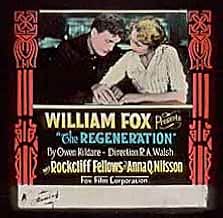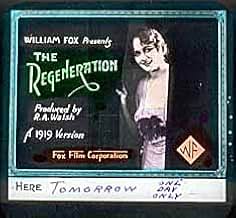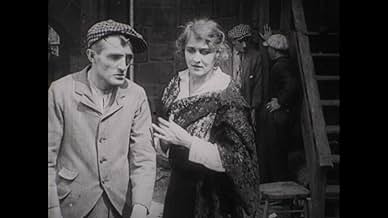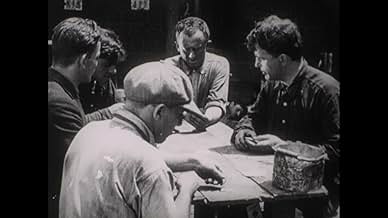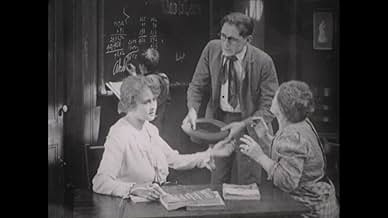NOTE IMDb
6,8/10
1,5 k
MA NOTE
Ajouter une intrigue dans votre langueA boy surrounded by violence grows up to become an infamous gangster.A boy surrounded by violence grows up to become an infamous gangster.A boy surrounded by violence grows up to become an infamous gangster.
- Réalisation
- Scénario
- Casting principal
- Récompenses
- 1 victoire au total
James A. Marcus
- Jim Conway
- (as James Marcus)
Harry McCoy
- Owen - Age 17
- (as H. McCoy)
Peggy Barn
- Woman
- (non crédité)
William Dyer
- Drunk Friend of Jim Conway
- (non crédité)
Avis à la une
Rather than repeat what others have written, I'd like to comment on how this film managed to get into circulation.
The only known print of the film was found in the basement of a building in Montana in 1976. Preserved (and not too soon given the deterioration seen in the middle of the film), it was part of a series of films shown during the New York Film Festival representing titles which had recently (1978) been saved. I remember seeing all of them; they included Lillom (recently issued on DVD in the Murnau/Borzage box and worth seeing), and The Letter (with Jeanne Eagles, which blew everyone away).
It is a miracle that films still turn up in such a manner even this late in the game. Most films from this time period have long ago turned into flammable dust (they started to deteriorate as early as the thirties), and it is particularly fortunate that "Regeneration" is now among the living. Despite its crudities, it feels like a documentary of the seedier elements of New York, and it still works its magic; it has matured very well. Given that we can see how the streets of New York really looked almost 100 years ago, the film may play better than it did back then. Most of the people in this film are not actors, they are real people, and that is what we reacted to when we saw this back in the seventies.
Additionally, the film is a real window into the transitional period when the one-reeler had turned into a longer, more ambitious feature. As a first feature for Walsh, this film is really extraordinary when we consider that the tools of film-making were still crude (the comments on the editing of the film are correct. However, the abruptness plays better on the big screen). Even more, the film also reminds us that the numerous features made between 1914 and 1920 included some real gems that are gone forever, and cannot be re-evaluated. How many really good actors and directors are known in name only because their work has disappeared?
I consider this one of the finest examples of an early silent feature, and one of the landmark films of the silent era. It is an illustration of how the director of that time found his or her way, made mistakes and had chances to improve. It shows how filmmakers were taking the vocabulary used by Griffith and some European filmmakers to expand the techniques of storytelling to hold an audience's interest for an hour's worth of entertainment.
A must-see if you are interested in silent films.
The only known print of the film was found in the basement of a building in Montana in 1976. Preserved (and not too soon given the deterioration seen in the middle of the film), it was part of a series of films shown during the New York Film Festival representing titles which had recently (1978) been saved. I remember seeing all of them; they included Lillom (recently issued on DVD in the Murnau/Borzage box and worth seeing), and The Letter (with Jeanne Eagles, which blew everyone away).
It is a miracle that films still turn up in such a manner even this late in the game. Most films from this time period have long ago turned into flammable dust (they started to deteriorate as early as the thirties), and it is particularly fortunate that "Regeneration" is now among the living. Despite its crudities, it feels like a documentary of the seedier elements of New York, and it still works its magic; it has matured very well. Given that we can see how the streets of New York really looked almost 100 years ago, the film may play better than it did back then. Most of the people in this film are not actors, they are real people, and that is what we reacted to when we saw this back in the seventies.
Additionally, the film is a real window into the transitional period when the one-reeler had turned into a longer, more ambitious feature. As a first feature for Walsh, this film is really extraordinary when we consider that the tools of film-making were still crude (the comments on the editing of the film are correct. However, the abruptness plays better on the big screen). Even more, the film also reminds us that the numerous features made between 1914 and 1920 included some real gems that are gone forever, and cannot be re-evaluated. How many really good actors and directors are known in name only because their work has disappeared?
I consider this one of the finest examples of an early silent feature, and one of the landmark films of the silent era. It is an illustration of how the director of that time found his or her way, made mistakes and had chances to improve. It shows how filmmakers were taking the vocabulary used by Griffith and some European filmmakers to expand the techniques of storytelling to hold an audience's interest for an hour's worth of entertainment.
A must-see if you are interested in silent films.
By the standards of its time, this is a better than average film, and it is still watchable, even though the social and cinematic conventions of 1915 may make it rather quaint to some viewers. Still, the theme about a good woman regenerating a rascal is not unusual today, and here it is told with coherence and simplicity.
One may find the acting style quaint, too, but some of the worst excesses of the silent days are avoided for the most part. Perhaps we can thank young Raoul for that. The editing is choppy, but that may be due to losses over the years, and it may vary depending on the print or tape translation one sees.
One may find the acting style quaint, too, but some of the worst excesses of the silent days are avoided for the most part. Perhaps we can thank young Raoul for that. The editing is choppy, but that may be due to losses over the years, and it may vary depending on the print or tape translation one sees.
I'm not a lover of silent cinema for a host of reasons, The Regeneration manages to avoid a couple but walks headlong into others.
It tells the tale of a young boy who loses his mother at a tender age, he's raised into violence and poverty and finds himself as an adult engaging in criminal activity. But when a kind hearted lady enters his life he finds himself questing for change, but can he escape his past?
The first thing that struck me about The Regeneration was how stunning it looks, there are movies made decades after this that don't look this good. The camera work is oddly crisp, the cinematography excellent and the performances are considerably less hammy than you'd expect from this era.
I feel like the movie would have been best served as a short, maybe at a 30-40 minute length. As a feature it dragged and the soundtrack though superior to most of it's ilk really does begin to grind on you.
The Regeneration is a wonderful attempt and one of the best of its type that I've seen, alas certain tropes of the genre that I despise meant it could only go so far.
The Good:
Looks incredible for its time
Great finale
The Bad:
Music gets old
Drags around the middle
It tells the tale of a young boy who loses his mother at a tender age, he's raised into violence and poverty and finds himself as an adult engaging in criminal activity. But when a kind hearted lady enters his life he finds himself questing for change, but can he escape his past?
The first thing that struck me about The Regeneration was how stunning it looks, there are movies made decades after this that don't look this good. The camera work is oddly crisp, the cinematography excellent and the performances are considerably less hammy than you'd expect from this era.
I feel like the movie would have been best served as a short, maybe at a 30-40 minute length. As a feature it dragged and the soundtrack though superior to most of it's ilk really does begin to grind on you.
The Regeneration is a wonderful attempt and one of the best of its type that I've seen, alas certain tropes of the genre that I despise meant it could only go so far.
The Good:
Looks incredible for its time
Great finale
The Bad:
Music gets old
Drags around the middle
Raoul Walsh had been an actor and an understudy assistant director under D. W. Griffith when Fox Films hired him to direct his first feature film, September 1915's "Regeneration." Many cite Walsh's full-length directorial debut as cinema's first gangster feature film.
Walsh had run away from home at 15 and worked a series of laborious, dangerous jobs, including a cow hand and a seafarer. His hands at that time were so calloused he refused to shake hands. Because of his horse-riding skills, D. W. Griffith hired him as an actor, with one of his first roles as a young version of Mexican revolutionist Pancho Villa.
Walsh showed enough of a curiosity of filmmaking that Griffith took him on as an assistant director, most notably helping him out in "The Birth of a Nation." In the 1915 film, Walsh also plays John Wilkes Booth, who kills Abraham Lincoln. Newly formed Fox Films Corporation heard and saw so many good things from Walsh that William Fox hired him to do one of his studio's first feature films.
"Regeneration," adapted from a 1908 play based on Owen Kildare's autobiography, was a redemption tale of a boy who grew up to become a criminal, but eventually realizing the wrongs he had committed through the guiding influence of a female social worker. Walsh decided to film in New York City's poor Lower East Side using actual criminals and prostitutes to heighten his movie's authenticity.
Elements of Griffith, who Walsh labeled as his teacher, is clearly visible in "Regeneration:" the masking of the lens, the parallel editing and camera positioning, numerous close ups and implementing newly devised cinematic techniques such as a handful of dolly movements. Certain scenes Walsh filmed contained chiaroscuro lighting, anticipating Germanic Expressionism film aesthetics by a few years.
Walsh would become one of Hollywood's auteurs noted for his hard-hitting, macho crime movies such as 1939's "The Roaring Twenties," 1941 "High Sierra," and 1949's "White Heat." He would direct until his final film in 1964, and have a script of his produced as a movie in 1970.
Walsh had run away from home at 15 and worked a series of laborious, dangerous jobs, including a cow hand and a seafarer. His hands at that time were so calloused he refused to shake hands. Because of his horse-riding skills, D. W. Griffith hired him as an actor, with one of his first roles as a young version of Mexican revolutionist Pancho Villa.
Walsh showed enough of a curiosity of filmmaking that Griffith took him on as an assistant director, most notably helping him out in "The Birth of a Nation." In the 1915 film, Walsh also plays John Wilkes Booth, who kills Abraham Lincoln. Newly formed Fox Films Corporation heard and saw so many good things from Walsh that William Fox hired him to do one of his studio's first feature films.
"Regeneration," adapted from a 1908 play based on Owen Kildare's autobiography, was a redemption tale of a boy who grew up to become a criminal, but eventually realizing the wrongs he had committed through the guiding influence of a female social worker. Walsh decided to film in New York City's poor Lower East Side using actual criminals and prostitutes to heighten his movie's authenticity.
Elements of Griffith, who Walsh labeled as his teacher, is clearly visible in "Regeneration:" the masking of the lens, the parallel editing and camera positioning, numerous close ups and implementing newly devised cinematic techniques such as a handful of dolly movements. Certain scenes Walsh filmed contained chiaroscuro lighting, anticipating Germanic Expressionism film aesthetics by a few years.
Walsh would become one of Hollywood's auteurs noted for his hard-hitting, macho crime movies such as 1939's "The Roaring Twenties," 1941 "High Sierra," and 1949's "White Heat." He would direct until his final film in 1964, and have a script of his produced as a movie in 1970.
I became obsessed with this movie two years ago after checking it out of our great NYC library. I rave about it to my friends. To think that this full-length feature was made in l915 is astounding. Maybe it's because of its amazing star, Rockliffe Fellowes, who looks so much like Marlon Brando you'll be double-takes. That he never became a legendary star is a real tragedy but when you think of it, almost none of the film actors from that era survived into the 20s except for Mary Pickford and a few comedians. Rockcliffe is so natural, as is his co-star, the beautiful Anna Q. Nillsen, you have to remind yourself that they were acting. This movie should be studied in film courses to show today's younger movie buffs what dynamic work was being done back int he "dinosaur" age of films. And maybe, like myself, they'll never forget the fantastic Rockliffe Fellowes. This guy "coulda been a contendah!"
Le saviez-vous
- AnecdotesMost of the extras in this film were real locals from the Bowery area, as well as from Hell's Kitchen, and had never appeared before in films. Most of the gangster characters were actual gangsters in real life.
- Citations
District Attorney Ames: Very fine and loyal, my boy, but you can't save your friend, and you have lost whatever chance you had - with her.
- Crédits fousThere is no cast list during the opening credits or at the end. Actors, however, are credited by intertitles as they appear within the movie, and that is used for the IMDb cast ordering. Actors never mentioned are marked uncredited.
- Versions alternativesKino International released a version which runs 72 minutes and contains an uncredited piano score.
Meilleurs choix
Connectez-vous pour évaluer et suivre la liste de favoris afin de recevoir des recommandations personnalisées
Détails
- Date de sortie
- Pays d’origine
- Langue
- Aussi connu sous le nom de
- Régénération
- Lieux de tournage
- Hudson River, Nyack, New York, États-Unis(burning of the excursion barge)
- Société de production
- Voir plus de crédits d'entreprise sur IMDbPro
- Durée
- 1h 12min(72 min)
- Couleur
- Mixage
- Rapport de forme
- 1.33 : 1
Contribuer à cette page
Suggérer une modification ou ajouter du contenu manquant

